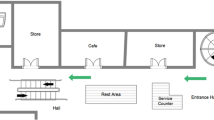Abstract:
People with severe visual impairment need a means of remaining oriented to their environment as they move through it. A series of indoor and outdoor trials using a variety of technologies and interfaces led to the development and evaluation of three promising wearable orientation interfaces: a virtual sonic beacon, speech output, and a shoulder-tapping system. Street crossing was used as a critical test situation in which to evaluate these interfaces. The shoulder-tapping system was found most universally usable. Results indicated that, given the great variety of co-morbidities within this population, which is comprised of mostly older persons, optimal performance and flexibility may best be obtained in a design that combines the best elements of both the speech and shoulder-tapping interfaces.
Similar content being viewed by others
Author information
Authors and Affiliations
Rights and permissions
About this article
Cite this article
Ross, D., Blasch, B. Development of a Wearable Computer Orientation System . Personal Ub Comp 6, 49–63 (2002). https://doi.org/10.1007/s007790200005
Issue Date:
DOI: https://doi.org/10.1007/s007790200005




